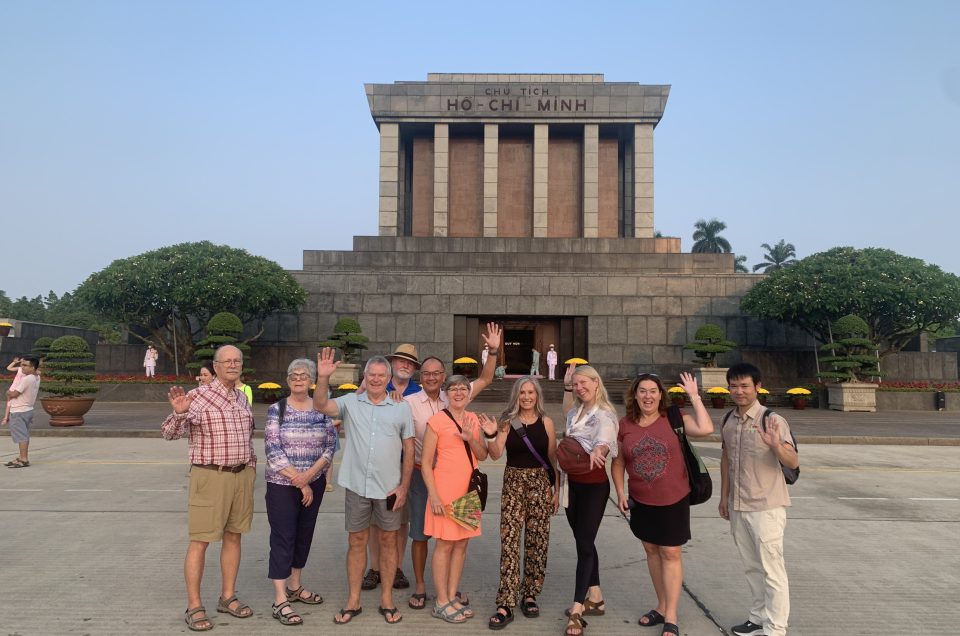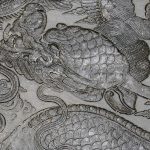(One of Must-see Hanoi Attractions)
Due to its immense historical significance, Ho Chi Minh’s Mausoleum has traditionally been regarded as the first location newcomers to Hanoi should visit. To pay tribute to Ho Chi Minh, the Greatest President who led Vietnam to independence, everyone wishes to travel there on a pilgrimage. Visitors can expand their understanding of Vietnam’s history, which is mirrored in the complex’s components, in addition to learning more about Ho Chi Minh’s life and place in Vietnamese history, by visiting the complex.
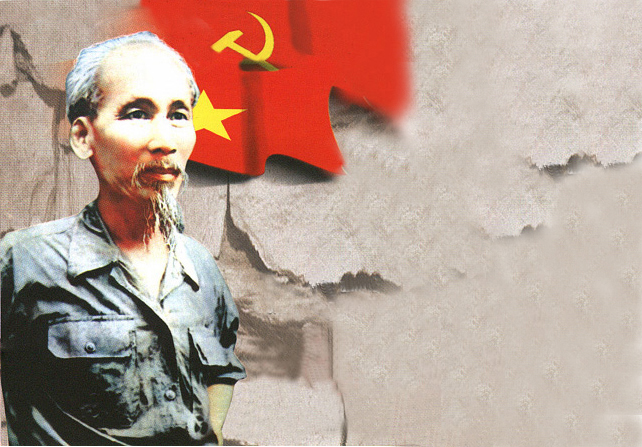
Who is Ho Chi Minh?
Ho Chi Minh, also known by the names Nguyen Sinh Cung and Nguyen Tat Thanh or Nguyen Ai Quoc, was the most recognizable and revered national hero of Vietnam in addition to being a revolutionary and politician. He was born on May 19, 1890, and died on September 2, 1969.
Ho Chi Minh, a vocal advocate for Vietnam’s independence since the turn of the 20th century, founded the Vietnamese Communist Party and served as its first leader for about 30 years. He was North Vietnam’s president from 1945 to 1969 and its prime minister from 1945 to 1955. Vietnamese rebel forces won the struggle against French colonialism under his leadership.
One of the most important communist leaders of the 20th century was Ho Chi Minh. He has continued to serve as the emblem of Vietnamese independence and emancipation up until this point.
Want to know more about the liberation of Vietnam? Visit the Complex of the Ho Chi Minh Mausoleum!
Ho Chi Minh Mausoleum Complex
One of Vietnam’s most revered historical tourism destinations is the Ho Chi Minh Mausoleum Complex. While there, visitors can discover a lot about Uncle Ho’s life and the liberation of Vietnam under his leadership. It is advised that visitors who are visiting this complex for the first time do the following:
Vietnamese First Independence Day was celebrated in Ba Dinh Square.
The mausoleum of Ho Chi Minh (where Uncle Ho’s embalmed bones are still kept),
Vietnamese Museum
Ho Chi Minh’s stilted residence
The Presidential Palace (Vietnam’s White House)
One-Storied Pagoda
The House No. 54, a noteworthy historical location.
Ba Dinh Square
When the French colonial authority first arrived in Hanoi more over a century ago, this region was rapidly selected as the political hub of Tonkin/the North and later the Indochinese Federation. As a result, a number of sizable structures designed in the French style can still be seen there today. These structures once housed the important colonial offices of the French administration.
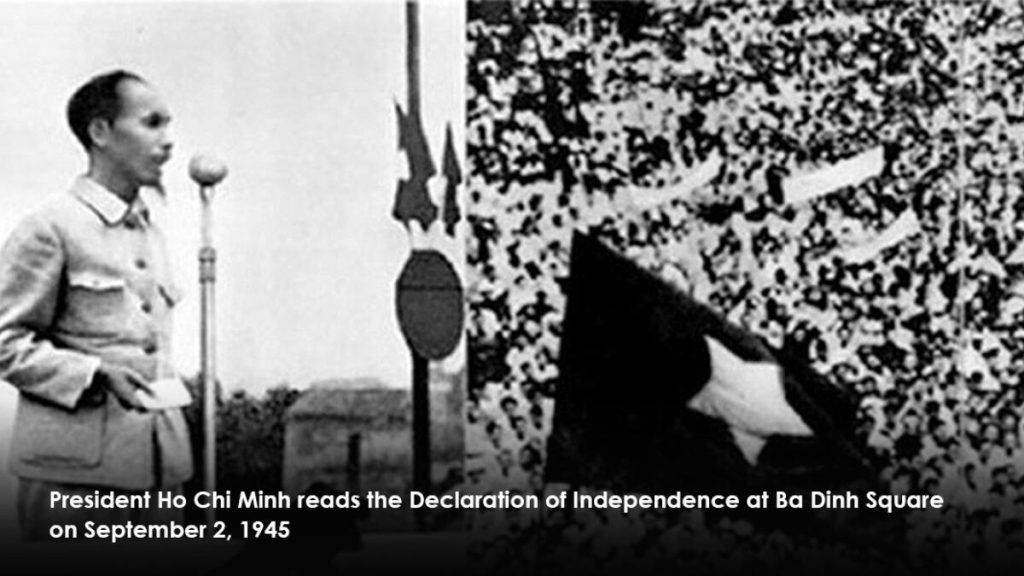
Ho Chi Minh and his allies seized control of the entire nation during the August Revolution and the end of French colonialism, renaming this location Ba Dinh Square. The first struggle against French colonialists was fought in Thanh Hoa, and the name Ba Dinh, which translates to “Three Communal Houses,” was originally the name of a village there. Following independence, the Square was given this name as a nod to the valiant but arduous resistance of the Vietnamese people in the past.
The Democratic Republic of Vietnam was founded on September 2, 1945, when Ho Chi Minh read the Vietnamese Independence Declaration in Ba Dinh Square. After Uncle Ho Vietnamese Great Father passed away, the Vietnamese people made the decision to build the Ho Chi Minh Mausoleum on the location of the former Ba Dinh Square in order to pay tribute to his contribution to the nation’s freedom and to serve as a reminder to future generations of that historical event.
Ho Chi Minh Mausoleum
The North, which was under our government’s control, and the South, which was under American control, were the two halves of the country during the Vietnam War against America. As a result, residents of these two regions were unable to interact throughout that time.
As a result, the Southerners were constantly anticipating the Great Father and expecting to one day meet him. President Ho, however, passed away before the nation was fully united. It influenced the choice to build Ho Chi Minh’s Mausoleum, which houses his remains and allows visitors to pay their respects once the nation is at peace once more.
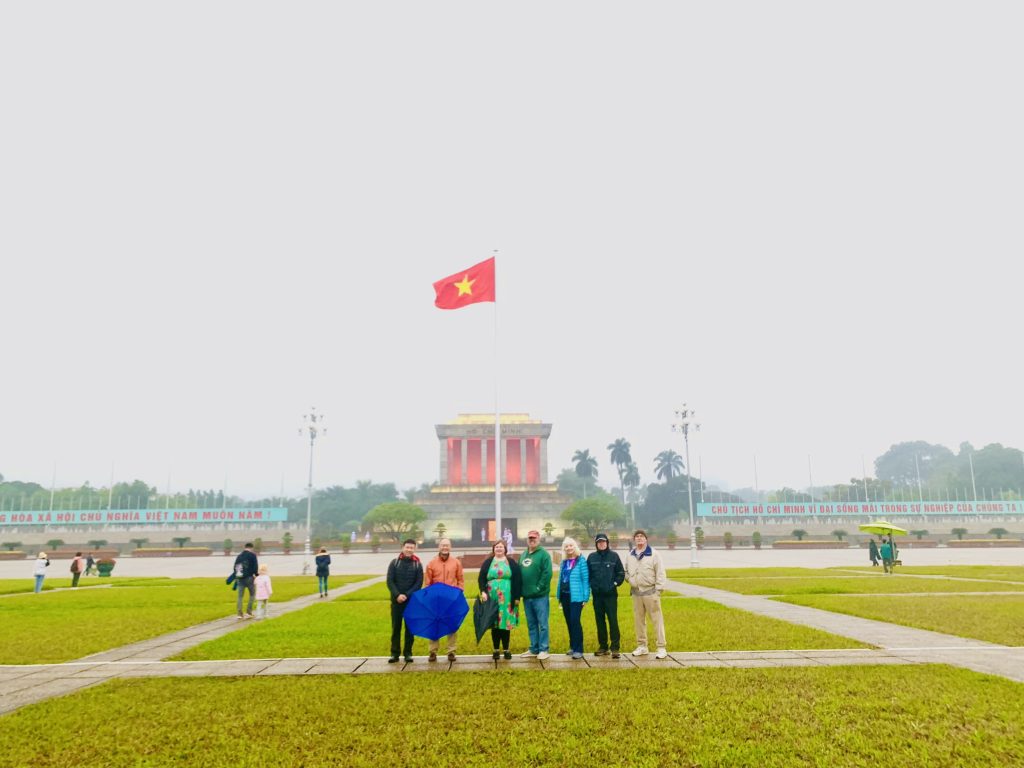
Actually, when President Ho was still alive, he just requested a straightforward funeral, in which his remains would be burned and then interred in three specific locations throughout Vietnam.
The first segment would cover the region in the North where he worked, the second segment would cover the region in the Middle where he was born, and the last segment would cover the region in the South where he initially began his quest to find a means to free Vietnam. However, because Ho Chi Minh has become so deeply ingrained in the Vietnamese character, the Vietnamese people for the first time disobeyed him, had a national burial, and attempted to preserve his body for many years in this Mausoleum.
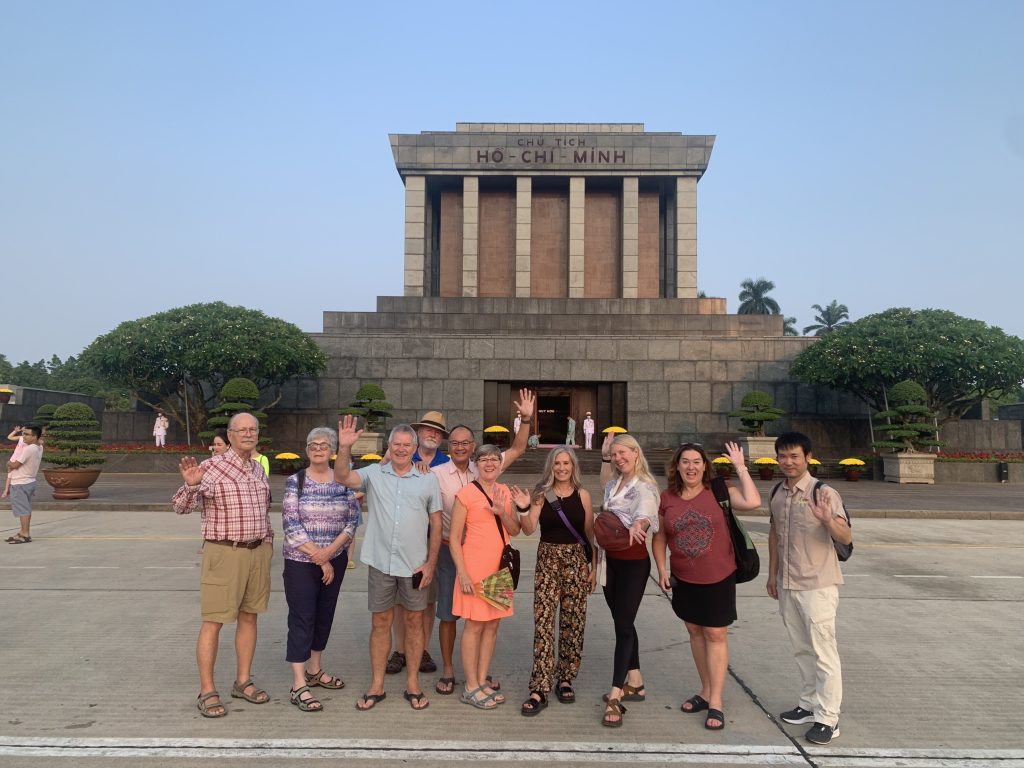
Vietnamese experts of the era had to travel to the Soviet Union to master the technique in order to preserve Uncle Ho’s body for a long time. Following the passing of Vietnam’s Great Father, these professionals began embalming President Ho with the assistance of Soviet Union experts. After that embalming procedure, his remains was preserved in a sterile setting in unnoticed locations while he awaited the tranquil day and the mausoleum’s completion.
The Soviet Union not only assisted with the embalming procedure but also with the construction of the Uncle Ho Mausoleum in Vietnam. Lenin’s Tomb in Moscow served as an inspiration for the Ho Chi Minh Mausoleum’s design, which was altered to better suit Vietnamese customs and way of life.
Five sections make up the mausoleum, which is encircled by several marble columns. This five-part building is meant to resemble the rural Vietnamese traditional home where President Ho was born and raised. The words “President Ho Chi Minh” are carved out of red plum marble and are located on the mausoleum’s exterior. The characters stand for Uncle Ho’s integrity and loftiness.
This Mausoleum stands out due to the fact that all of its components, including the many flora used as adornment, were sourced from various regions of Vietnam. Each province in Vietnam chose to provide one signature material to the construction of the Mausoleum at that time in order to honor President Ho Chi Minh. This gesture not only shows the nation’s affection for the Great Father but also its togetherness as a whole.
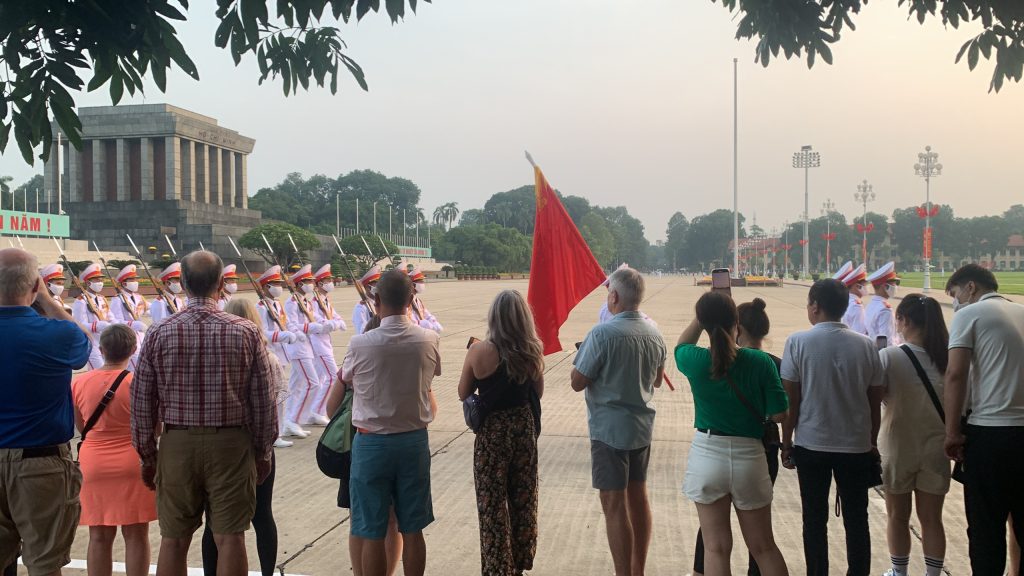
There is a gilded version of Ho Chi Minh’s well-known aphorism “Nothing is more precious than Freedom and Independence” inside the Mausoleum. Additionally, there are two flags on the wall: the Communist Party flag and the Vietnamese national flag, both of which were created from the 4000 rubies from Thanh Hoa Province.
The embalmed body of President Ho is displayed on a bronze platform decorated with lotus designs (the national flower of Vietnam), which is affixed to a rock pedestal with an automatic lift mechanism (built to move Uncle Ho’s body in an emergency). It is secured by numerous military honor guards, maintained in a glass case, and placed in the middle of the mausoleum. The environment here is so cool that Ho Chi Minh’s embalmed body wouldn’t be harmed.
- Location: 25 Hung Vuong, Dien Ban, Ba Dinh, Hanoi
- Opening days: Tuesday, Wednesday, Thursday, Saturday, Sunday
- Opening hours:Seasonal:
- April 1st to October 31st: 7.30 a.m 10.30 a.m (Saturdays, Sundays and public holidays: 7.30 a.m 11.00 a.m)
- November 1st to March 31st of next year: 8.00 a.m 11.00 a.m
- Entrance fee: Free
- Phone: (+84)24 3845 5128
Ho Chi Minh Museum
To commemorate Ho Chi Minh’s 100th birthday, this unique museum was built within the Ho Chi Minh Complex and took nearly 5 years to build. Ho Chi Minh Museum features three levels and is shaped like a 20-meter-tall, enormous white flower.
Meetings for both domestic and international Vietnam usually take place in the 400-seat hall on the ground floor. A massive museum with more than 2000 rare historical artifacts and exhibits, which chronologically depicts Uncle Ho’s working life and Vietnam’s revolutionary stages, has been set up on the second floor.
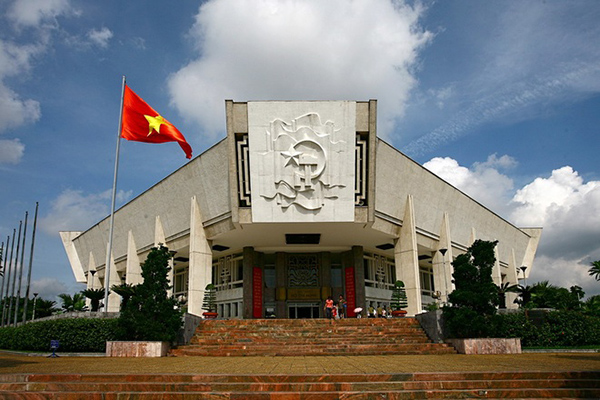
The exhibition here contains three main contents:
- How Vietnamese people follow Ho Chi Minh’s Testament and How was his life as well as Revolutionary Cause.
- How Vietnamese people’s Life turned from Poverty into Victory under the lead of Uncle Ho.
- The world’s major historical events, shown in 8 halls.
- Location: 185/19 Ngoc Ha, Doi Can, Ba Dinh, Hanoi
- Opening days: Tuesday, Wednesday, Thursday, Saturday, Sunday
- Opening hours:
- Morning: from 08:00 to 12:00
- Afternoon: from 14:00 to 16:30
- Phone: 024 3846 3757
- Entrance fee: 25.000 VND (~$1)
The Presidential Palace
For the French Indochina Governor, a German architect designed and oversaw the construction of this structure. With more than 30 rooms and a construction span of around 6 years, this was at the time the most opulent building. Originally known as the “Indochina Governor Palace,” the structure has gone by the moniker “The Presidential Palace” ever since the country’s Independence Day in 1945.
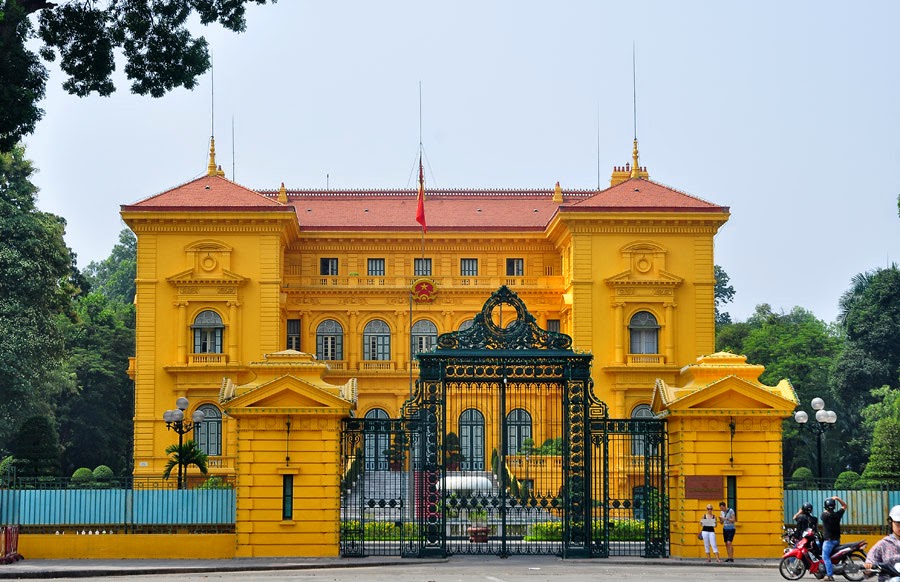
Ho Chi Minh’s residence and place of business had been planned for this location. Uncle Ho, however, refused to do that, claiming that it would be inappropriate for him to dwell in such a luxurious, enormous building while the other tenants were destitute and going hungry. Instead, he resided in House No. 54, a little residence in the garden. Only critical delegation meetings and visits from young Vietnamese youngsters to their adored Uncle Ho took place at the Presidential Palace.
Nowadays, The Presidential Palace is mostly used for welcoming foreign national officials as well as governments from all over the work coming to Vietnam.
- Location: 2 Hung Vuong street, Ngoc Ha, Ba Dinh, Hanoi
- Not Allowed to go in
House No.54
The previous owner of this modest home was an electrician who was responsible for the Governor Palace. However, this was President Ho’s residence and place of employment from 1954 to 1958. Since Ho Chi Minh was known for leading such a humble life, practically every amenity in this home was a gift from strangers from all around the world. Rumor has it that Uncle Ho refused to buy new furniture when urged to do so because “they (the furniture) are good and they are gifts from my friends, so nothing can be compared.”
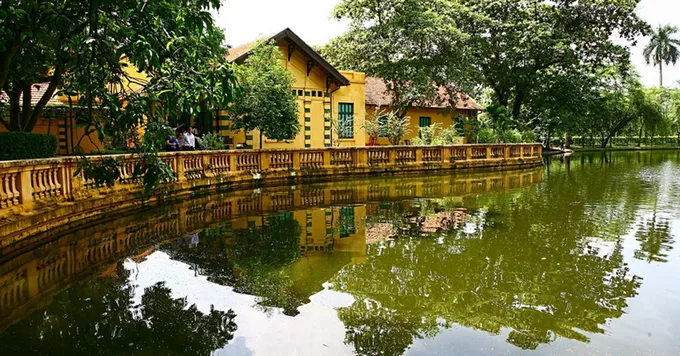
This little house has three rooms. The first is President Ho’s office, which is located in the living room. Unquestionably a unique individual, Ho Chi Minh owned hundreds of books on a variety of subjects, all of which were perfectly organized in this area. On his table, he kept a toy that symbolized the relationship between Vietnam and the Soviet Union. Visitors would adore this item.
Moving on to the kitchen, the second room had a thermometer, and Ho Chi Minh would approach the Prime Minister of Education to grant a day off for primary children anytime the temperature fell below 10 Celsius. The current day still sees the application of this rule.
His basic bedroom is in the third space. People would discover a round table with a statue of Khuat Nguyen the Poet on it as a gift from Cuba’s Great Leader Fidel Castro.
Uncle Ho’s car collection is one item that tourists will undoubtedly be interested in. There are three vehicles: a long-distance vehicle (the Pobeda, a gift from the Soviet Union), a city vehicle (the Peugeot, a gift from the French and Vietnamese), and a third vehicle, the Zis. Only the national leaders of the Allies were given access to the Zis’ limited production. It weighs 3 tons, measures 6 meters long, and has a bulletproof shell that is 10 centimeters thick.
Ho Chi Minh devoted his entire life to the freedom of Vietnam. He therefore lacked a wife and offspring. According to legend, Uncle Ho would switch on the radio, a present from Hungarian students, in the late evening after everyone had returned home and the day’s work was complete because he “needs to hear a human voice to warm up.”
President Ho Chi Minh continued to visit this home for lunch, dinner, and personal hygiene even after he moved to the stilt house to live and work.
Ho Chi Minh’s Stilt House
President Ho relocated to this stilt house after residing at House No. 54 for four years. To remind him of the difficult days spent getting ready for the Revolution, this house was built to resemble the stilt dwellings common in Northern hilly areas. The home has two floors; the bottom level is used for gatherings, and the upper level houses the bedrooms, study areas, and bookcases.
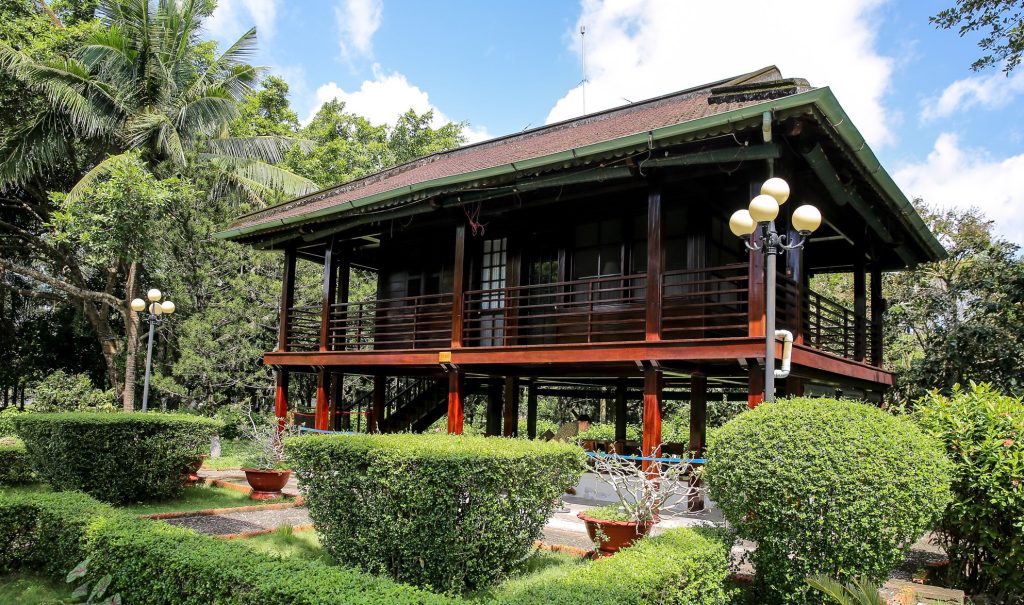
Walking around, visitors can feel Uncle Ho’s simple and pure lifestyle as there are a lot of trees from various places of Vietnam. There are also fish ponds which raise anabas and golden carps. As rumours go, whenever feeding the fishes (always at the same time), Uncle Ho clapped his hands and therefore the fish quickly learned the habit of hearing the sound and coming up on the surface, even long after his death.
- Location: 1 Bach Thao Lane, Ngoc Ha street
- Entrance fee: 25.000 VND (~$1)
One Pillar Pagoda
In 1049, during the reign of King Ly Thai Tong, the pagoda was constructed. A tower (Lien Hoa lotus flower) and a pagoda (Dien Huu long lasting bliss) were harmoniously combined and placed in the center of a rectangular lotus lake.
This pagoda has the appearance of a lotus emerging from a pond. According to legend, King Ly Thanh Tong had a dream that gave the One Pillar Pagoda its unique appearance. According to legend, King Ly Thai To was extremely old and without a son in the 11th century. He therefore traveled to numerous pagodas to seek the Buddha’s blessing in order to receive one. Before having a peculiar dream one day in which he encountered the Goddess of Mercy when she was perched on a lotus flower and handed him a bright son. A nice prince was born to the queen not long after.
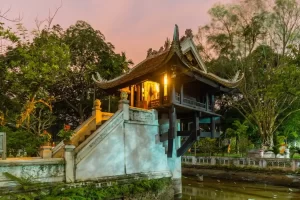
The King made the decision to build a pagoda in the form of a lotus flower, supported by just one pillar, as a way of paying back the Goddess of Mercy.
Unfortunately, the pagoda that is currently located in Hanoi is not the original one. The Original One Pillar Pagoda was mined and destroyed by French soldiers on September 11, 1954. Uncle Ho was compelled to repair it following the Fourth of July, and it was finished in 1955. The modern One Pillar Pagoda is thought to be considerably smaller than the original.
- Location: Doi Can, Ba Dinh, Hanoi
- Entrance fee: Free
Tips on Visiting
- Dress code: Visitors are supposed to wear formal clothes. Shorts, mini-skirts, sleeveless shirts, tank tops and so on are not allowed.
- Please do not make noise since this is a solemn place.
- Cameras, mobile phones, and day packs will be collected by the guards before you enter the Mausoleum.
- No shooting or video recording in restricted areas.
- Do not carry food, electronics or jewelry.
- Children have to be over 3 years old to be able to enter.
Traveling means not only relaxing but also exploring. If you consider yourself a knowledge-minded person, the one who always pays attention to the destination’s history, or even if you just want to enjoy peaceful sightseeing, this complex is definitely an appropriate area for you.

